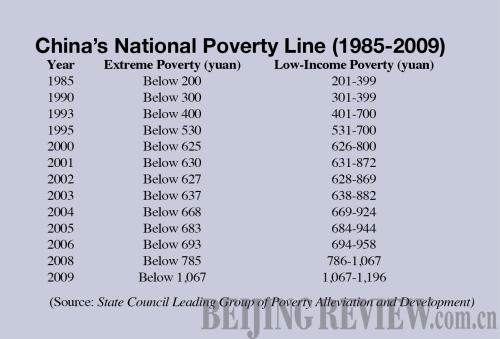|
In this sense, lifting the poverty line could be seen as a signal of the government's effort to improve the living standards for the impoverished, the report added.
Changing the limits for the poverty line will surely lead to an increase in the population below the poverty line, but it's not necessarily a result of economic stagnation, and is more an effort to raise the living standard of the low-income population, said Huang Chengwei, Deputy Director of the China International Poverty Reduction Center.
More space for growth
Raising the poverty line from 1,196 yuan in 2009 to 1,500 yuan will surely increase the spending capability for the impoverished, which will have a positive impact on economic growth. In terms of poverty alleviation, government funding has always been the biggest player in promoting economic growth. For years, to develop areas with concentrated poverty has been on the top of the Chinese Government's agenda.
Eliminating absolute poverty, Fan said, will be China's top priority in the next decade. China will strive to significantly reduce its impoverished population by 2015 and will basically eliminate absolute poverty by 2020.
Fan said China will adhere to the principle of overall development to promote employment, increase revenue, improve people's livelihoods and speed up development. The government will also play a leading role in enhancing sustainable development in impoverished areas.
This year China will strive to alleviate poverty in areas with concentrated poverty and special difficulties, including Tibet, Tibetan-inhabited areas in Sichuan Province and the southern part of the Xinjiang Uygur Autonomous Region by launching integrated planning and investment.
The Central Government and governments at various levels will further strengthen funding for poverty reduction and gradually establish a steady increase mechanism to provide funds for poverty-reduction programs. In 2010, China saw a consecutive increase in its input of special funds for poverty reduction, totaling 35.2 billion yuan ($5.3 billion), among which 22.2 billion yuan ($3.4 billion) came from the central coffer and 13 billion yuan ($1.97 billion) from local governments.
Adhering to integrated development of urban and rural areas and focusing on promoting employment, increasing income, improving people's livelihoods and accelerating development, China has endeavored to strengthen the capability of sustainable development in impoverished areas, said Fan. He claimed the efforts in poverty reduction will create many investment opportunities in construction, education, medical treatment, public health and international trade. The inflow of international capital and technology will improve the efficiency of China's poverty reduction and create business opportunities as well, he said.
Great achievements
At the National Poverty Reduction Conference, held on December 21, 2010, it was announced that in the first decade of this century, China saw a significant decrease in its rural impoverished population.
According to the State Council Leading Group of Poverty Alleviation and Development, from 2001 to 2009, China reduced poverty significantly. In 2000, the number of people living below the poverty line was 94.23 million, or 10.2 percent of China's total population of 1.3 billion. In 2009, those living below the poverty line totaled 35.97 million, or 3.8 percent of the population.
In the past decade, China has also noticeably enhanced its infrastructure construction in impoverished areas, and the proportion of rural residents with access to safe drinking water increased markedly.
According to the global rural poverty report released by the UN International Fund for Agricultural Development (IFAD) on December 6, 2010, during the past decade, the overall rate of extreme poverty in developing countries' rural areas—people living on less than $1.25 a day—dropped from 48 percent to 34 percent. Dramatic gains in East Asia, particularly China, account for much of the decline—the number of extreme poor in China fell by about two-thirds from 365 million to 117 million, as did its rate of extreme poverty, from 44 percent to 15 percent.
The decline is mainly due to increased production and higher levels of private investment in the farming sector, as well as increased urbanization across the developing world, said the report.
The Chinese Government is fully aware of the fact that efforts to alleviate poverty will still face mounting challenges in the next 10 years.
According to Fan, of the 35.97 million of China's impoverished population in 2009, 62.3 percent were people thrown back into poverty after achieving non-poverty status. The drastic rise and fall of the poverty-stricken population fully demonstrates the vulnerability of the poor and the complexity of the causes of poverty.
In addition, natural disasters, market and environment factors and other elements have further added to the difficulty of poverty reduction, said Fan. China's poverty alleviation and development will remain a difficult task in the coming decade, he added.

| 